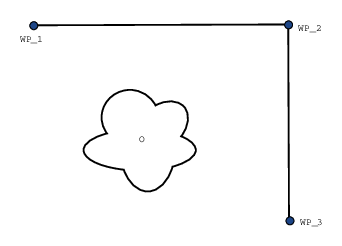|
The robot starts at waypoint 1 (WP_1),
and it needs to pick up an object at waypoint 3 (WP_3).
To avoid collisions with the object and other obstacles
,
the robot must avoid (O) by using waypoint 2 (WP_2).
Three waypoints are introduced to create a path that fulfills the requirements.

14.1: (WP_1): initial position, (WP_2): via point, (WP_3): pick up position, (O): obstacle.
Without configuring other settings, the robot will make a very brief but full stop at each waypoint, before continuing the movement.
For this task a stop at (WP_2)
is not optimal since a smooth turn would require less time and energy while still fulfilling the requirements. It is even acceptable that the robot does not reach (WP_2)
exactly, as long as the transition from the first trajectory to the second trajectory happens near this position.
The stop at
(WP_2)can be avoided by configuring a blend for the waypoint.
This allows the robot to calculate a smooth transition into the next trajectory.
The primary parameter for the blend is a radius.
When the robot is within the blend radius of the waypoint, it can start blending and deviate from the original path. This allows for faster and smoother movements, as the robot does not need to decelerate and re-accelerate.
|